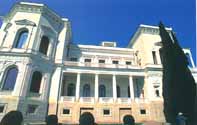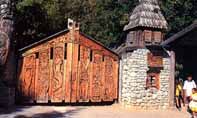|
I
was watching the horizon from the balcony of an enchanted castle
perched on the edge of a cliff overlooking the sea. The water was
tranquil, its gentle waves lapping on the shore far below. The
name of this miniature copy of a medieval German castle was the
Swallows Nest. I looked in vain for a prince in a white motor boat,
and decided that the next best thing would be to go inside and enjoy
some delicious fish accompanied by wine. If you still cannot guess,
I was in Yalta, on the south coast of the Crimea. But I should begin
my story from the beginning.
Simferopol is the capital of the autonomous
Republic of the Crimea. The Crimea has been a region of Ukraine
since 1954, and an autonomous republic responsible for its own
internal affairs since 1991. Simferopol is also the jumpoff point
for Yalta, the countrys principal summer resort which attracts
large numbers of tourists from abroad, particularly Russia.
Simferopol was founded in the early 16th
century as the Crimean Tatar town of Ak-Mechet on the left bank of
the Salghir river which rises in the Crimean Mountains. After being
annexed by Russia in the late 18th century, Simferopol was appointed
main city of the Taurian Region and given its present name. At the
end of the 19th century the city began to develop on the right bank
of the river. Today the Salghir, with its ornate iron bridges flows
through one of the most beautiful parks in the city, where the trees
were ablaze with autumn colors when I saw it.
The Central Market and Pushkin Street are the
liveliest places in Simferopol. In the Central Market you can find
everything from fresh fruit and vegetables to paintings and
souvenirs. Bargaining is part of the shopping culture here, so give
it a try.
Lined by cafés and restaurants, Pushkin
Street is thronged with people until late at night. Here there are
more of the statues which you encounter all over the city, and at
one end is the magnificent Gorky Theatre, the oldest theatre in the
Crimea, its marble façade adorned with statues and cawing.
In Simferopol time passes at a measured pace,
while in nearby Yalta the hours rush by exuberantly. Simferopol is
as calm and dignified as Yalta is gay and jubilant. When it is
raining or even snowing in Simferopol, Yalta basks in a
Mediterranean climate, their weather reflecting their functions as
centers of politics and entertainment respectively.
According to some Yalta is a false paradise,
to others a place to seek health. Yalta has provided a refuge for
many writers, including Mark Twain, Anton Chekhov, and Tolstoy. But
for me it is a land of fairytale.
Barbaros Bey, owner of Yaltas famous
Turkish restaurant, Victoria, says that here everyone finds the
holiday they are seeking. The lofty Crimean Mountains are a barrier
to the cold north winds, so that Yalta enjoys sunny mild weather for
most of the year and it is possible to swim until December.
The esplanade is lined by cafés, restaurants
and shops, and the nightlife continues its hectic pace until the
small hours of the morning. At the rows of stalls you can find many
original souvenirs unique to the region for yourself and your
friends, but the most enjoyable is to pose for one of the street
artists who will draw or paint your portrait in pencil, water
colors or pastels.
There are many historic places of interest in
Yalta, the most famous of all being Livadia Palace where Roosevelt,
Churchill and Stalin met for the Yalta Conference, at which these
three leaders discussed final plans for the defeat of Germany. The
palace is a former summer residence of the Tsars and is set in a
park of equal splendour. Another palace not to be missed is
Vorontsov Palace in Alupka. Built in the 1840s, this too is set in
large colourful gardens. The most fascinating feature of the palace
is the portal built to resemble a mosque, with six stone lions on
guard on the steps. Along the cornice is a quotation in Arabic
script reading, There is no conqueror but Allah, (spoken by
Muhammed I, who built the Alhambra Palace in Spain) chosen by Count
Vorontsov to reflect his wish that all societies should live in
peace.
|

|
Now we go on to the Foros Church located high
in the Krasnaya Mountains between heaven and sea. The gilded
onion domes dazzle your eyes as the sunlight plays on them. The
church is not large, but the interior is exquisitely decorated with
paintings by Italian and Russian artists. The church, which dates
from 1892, stands quite alone in its remote mountainous setting, as
fin retreat from the world.
|

|
I said that for me
Yalta is a land of fairytale. That is because in the most unexpected
places you come across reminders of local legends. In the middle of
the sea ,for example, there is a statue of a woman holding a child.
This represents Arzu, who was kidnapped by corsairs but escaped
their clutches by throwing herself into the sea at the last moment.
If you want to listen to the Crimeas other legends, then you must
do as I did and visit Polyana Kazok. This is an open air museum of
wooden and stone statues by Crimean artists, all depicting heroes of
legend or fairytale. Most of them will be familiar. Just call up
your childhood recollections, and if they fail you, do not worry,
because you can ask for help from the storyteller at the door. Look
carefully at every tree, even at a brunch on the seashore, and watch
out for the ancient witch who has lived in her cottage in the
forest for centuries.
|